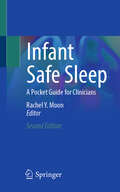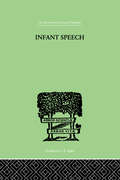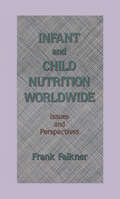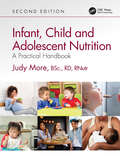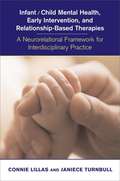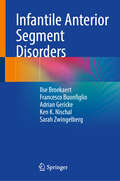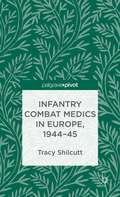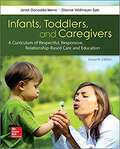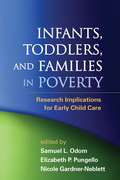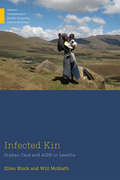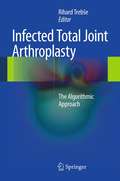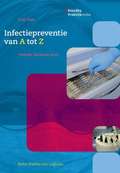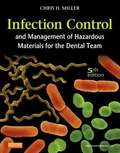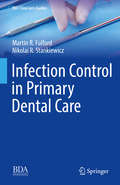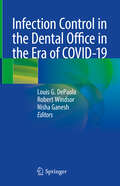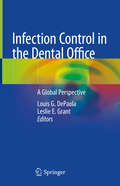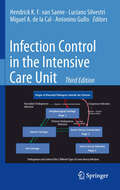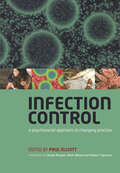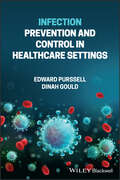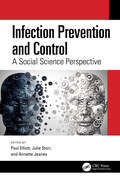- Table View
- List View
Infant Safe Sleep: A Pocket Guide for Clinicians
by Rachel Y. MoonThis book is a practical, comprehensive look at safe sleep for infants, including infants with co-occurring medical conditions. It offers guidance for clinicians who are counseling parents and other infant caretakers, and discusses common barriers to adherence and approaches that are evidence-based or use behavior change theory. Chapters focus on pathophysiology, important aspects of the sleep environment, and infant product safety. There is a closing chapter on grief and counselling families after a loss. Chapters open with a clinical vignette and close with a discussion of frequently encountered questions, and clinical pearls and pitfalls. All chapters have been fully revised to include the most current research. Three new chapters have been added on the genetics of sudden and unexpected death, infant biomechanics and implications for safe sleep, and firm and flat sleep surfaces. Infant Safe Sleep, 2e, is a valuable resource for pediatricians, other clinicians, healthcare and public health professionals, and others caring for children.
Infant Speech: A STUDY OF THE BEGINNINGS OF LANGUAGE (International Library Of Psychology Ser. #Vol. 77)
by Lewis, M M"First Published in 1999, Routledge is an imprint of Taylor & Francis, an informa company."
Infant and Child Nutrition Worldwide: Issues and Perspectives
by Frank FalknerThis volume provides a contemporary and historical overview of infant nutrition in Europe, North America, and the Third World. It emphasizes the important role that good nutrition, appropriate health care, and a caring environment play in promoting healthy physical and social growth in children. Issues covered include breast feeding, maternal undernutrition and reproductive performance, weaning, and the social and pyschological factors of breast feeding. The book will serve as an excellent guide for nutritionists, pediatricians, health professionals and others involved in child welfare worldwide.
Infant, Child and Adolescent Nutrition: A Practical Handbook
by Judy MoreInfant, Child and Adolescent Nutrition: A Practical Guide, Second Edition, is an evidence-based, practical guide introducing readers to the theory behind optimal child nutrition. Containing practical advice on how to put that theory into practice, this new edition facilitates learning through case studies, key points, and learning activities. Divided into seven sections, chapters cover prenatal nutrition and nutrition throughout childhood from preterm babies to adolescents up to the age of 18. Sections throughout focus on topics ranging from nutrient requirements, balanced eating patterns and common problems to cultural influences on food choices and guidelines on assessing growth and dietary intakes. Prevention and management of obesity and allergies are covered in separate chapters. The first 1000 days are given particular consideration with chapters on diets for preconception, pregnancy, milk feeding and complementary feeding during infancy. The chapter on nutritional treatments covers common conditions such as diabetes and Crohn’s disease, as well as more intricate feeding regimes and tube feeding required for children with rarer diseases and syndromes. New in this second edition are: · Changes in in food allergy prevention and oral immunotherapy treatments. · Causes and management strategies to deal with fussy and selective eating in toddlers. · The importance of iodine in diets before and during pregnancy to improve children’s cognitive abilities. · Updated recommendations on vitamin D supplementation. This second edition is an essential reading for students taking courses in nutrition and paediatric healthcare. It serves as a useful reference for individuals responsible for the nutritional intakes of children in primary care and community settings including early years practitioners, midwives, health visitors, school nurses and governors, social workers, paediatricians and general practitioners. About the Author Judy More BSc, RD, RN is a Paediatric Dietitian, Honorary Lecturer at the University of Plymouth, UK and Director of Child-nutrition.co.uk Ltd, London, UK.
Infant/Child Mental Health, Early Intervention, and Relationship-Based Therapies: A Neurorelational Framework For Interdisciplinary Practice
by Connie Lillas Janiece TurnbullWhen early interventions with children fail, clinicians wonder: How could things have been different? The answers seem obvious at first, but a little reflection begins to unveil just how complicated this question really is. Who should have been included in the treatment? With what professionals and using what approaches? When should intervention have occurred? Each question involves a spectrum of both personal and societal issues, which is perhaps why problems that are so widely acknowledged remain so widely ignored. Often, a family is not aware that their story could have had a different ending. So, in response to the critical need for a more cohesive system of care for our youngest patients, this book presents a conceptual framework for interdisciplinary collaboration. Examining the issues of infant mental health and early intervention from a brain-based perspective--one that cuts across all domains--addresses the need for individual practitioners to incorporate the whole picture in relation to their part in assessing and intervening with each individual child and parent, and provides a global framework for team collaboration.
Infantile Anterior Segment Disorders
by Ilse Broekaert Francesco Buonfiglio Adrian Gericke Ken K. Nischal Sarah ZwingelbergThis book provides a practical overview of infantile anterior segment disorders in a clear and concise format. Genetics, new diagnostics, and surgical options for anterior segment disorders in children are highlighted with numerous high-quality illustrations as well as the pediatric spectrum of systemic diseases based on the experience of internationally active experts. Infantile Anterior Segment Disorders is an essential resource for all ophthalmologists seeking an easy-to-use resource for optimizing clinical expertise and outcomes related to these conditions.
Infantry Combat Medics in Europe, 1944–45
by Tracy ShilcuttMedics learned quickly to ignore standing operating procedures in order to save, lives but tensions within infantry units created a paradoxical culture of isolation and acceptance. This groundbreaking work examines training and combat experiences of soldiers working in Battalion Aid Stations and those who went as aid men to the line companies.
Infants Toddlers and Caregivers
by Janet Gonzalez-Mena Dianne Widmeyer EyerInfants, Toddlers, and Caregivers is an ideal introduction to care and education in the first three years of life, featuring a respectful approach inspired by field pioneers Magda Gerber and Dr. Emmi Pikler. The program provides practical information based on theoretical and research foundations that students can implement in a variety of infant and toddler settings. With the impacts of school readiness and technology in early childhood education today, this program focuses on the value of free play, the development of self-reliance, and the importance of responsive, respectful interactions. The Connect course for this offering includes SmartBook, an adaptive reading and study experience which guides students to master, recall, and apply key concepts while providing automatically-graded assessments.
Infants, Toddlers, and Families in Poverty: Research Implications for Early Child Care
by Samuel Odom Elizabeth P. PungelloIdentifying factors related to poverty that affect infants, toddlers, and their families, this book describes promising early child care and intervention practices specifically tailored to these children and families' needs. Leading authorities from multiple disciplines present cutting-edge research and discuss the implications for practice and policy. Contributors review salient findings on attention, memory, language, self-regulation, attachment, physical health, family processes, and culture. The book considers the strengths and limitations of existing early intervention services for diverse populations and explores workable ways to improve them.
Infected Kin: Orphan Care and AIDS in Lesotho (Medical Anthropology)
by Ellen Block Will McGrathAIDS has devastated communities across southern Africa. In Lesotho, where a quarter of adults are infected, the wide-ranging implications of the disease have been felt in every family, disrupting key aspects of social life. In Infected Kin, Ellen Block and Will McGrath argue that AIDS is fundamentally a kinship disease, examining the ways it transcends infected individuals and seeps into kin relations and networks of care. While much AIDS scholarship has turned away from the difficult daily realities of those affected by the disease, Infected Kin uses both ethnographic scholarship and creative nonfiction to bring to life the joys and struggles of the Basotho people at the heart of the AIDS pandemic. The result is a book accessible to wide readership, yet built upon scholarship and theoretical contributions that ensure Infected Kin will remain relevant to anyone interested in anthropology, kinship, global health, and care. Supplementary teaching materials are available at: https://www.csbsju.edu/sociology/anthropology-teaching-resources/useful-resources/infected-kin-teaching-resources
Infected Total Joint Arthroplasty
by Rihard TrebšeThere are a variety of protocols that are used in infected total joint arthroplasty. This book outlines and details the best possible course of treatment and formulate custom algorithms for every possible case, based on current evidence. It reviews current concepts and "recipes" for the diagnostic and therapeutic procedures (surgical and antibiotic) based on the type of implant, infection and the patient. This book is an essential resource on infected total joint arthroplasty, containing a series of logical and highly detailed instructions that will serve to educate orthopedic surgeons operating in this field on the best approaches, according to detailed and careful research conducted over the last decade.
Infectieleer en -preventie: Voor medewerkers in de mondzorg
by D.M. VoetInfectieleer en -preventie is geschikt voor medewerkers in de mondzorg die met patiëntenzorg of instrumentarium in aanraking komen. Het geeft op heldere en praktijkgerichte wijze inzicht in de thema's die belangrijk zijn in het voorkomen van infecties. Dit boek is geschreven voor (toekomstige) tandartsassistenten, maar is ook zeer geschikt als leerboek of naslagwerk op het gebied van gezonde praktijkvorming voor alle andere medewerkers in de mondzorg.
Infectiepreventie van A tot Z
by D. M. VoetPraktijkgerichte vakinforamtie voor de moderne tandartsassistent. De reeks is te gebruiken voor scholing, het opfrissen van kennis en als naslagwerk.
Infection Control and Management of Hazardous Materials for the Dental Team (Fifth Edition)
by Chris H. Miller Charles John PalenikEmphasizing patient safety and infection prevention in the dental office, Infection Control and Management of Hazardous Materials for the Dental Team, 5th Edition, covers everything from basic concepts in microbiology to protocols for clinical asepsis. Clear, step-by-step instructions make it easy for you to perform safety procedures and use the supplies and equipment needed to prevent the spread of infectious disease. New to this edition are full-color photographs and four new chapters on emerging topics. Written by oral biology and infection control expert Chris Miller, this resource is a must read for every member of the dental team. Comprehensive coverage follows dental assisting and dental hygiene curricula requirements for infection control, ensuring that you learn essential principles and procedures for clinical competence. Easy-to-follow, step-by-step procedures are provided for skills that dental team members must master, each presented with a goal, materials, chronological steps, and rationales for the performance of each step. Key terms begin each chapter and are highlighted within text discussions and defined in a back-of-book glossary. Summary tables and boxes make study easier by highlighting key concepts and procedures. Review questions ensure your comprehension of the material with 5 to 20 multiple-choice questions at the end of each chapter. Practical appendices offer easy access to the most significant regulatory agency rules and recommendations for infection control. Student resources on the Evolve companion website include practice exercises plus review questions and quizzes. NEW! Full-color photographs show the latest equipment, supplies, and procedures and accurately depict concepts in microbiology and the nature of infectious disease. Four NEW chapters cover changing and emerging topics and trends in infection control, including Hand Hygiene, Preventing Sharps Injuries, General Office Asepsis, and Cross-contamination Between Work and Home. NEW! Case scenarios on the Evolve companion website examine an infection control incident along with its potential consequences, possible preventive measures, and related recommendations and regulations. UPDATED content includes new areas such as technology involving surface and equipment asepsis, dental water unit air quality, and green infection control.
Infection Control in Primary Dental Care (BDJ Clinician’s Guides)
by Martin R. Fulford Nikolai R. StankiewiczThis book is an easy-to-use guide to all aspects of infection control and decontamination that will support the implementation of effective measures for risk reduction in dental practice. Among the topics addressed are the principles and practicalities of cleaning and sterilizing dental instruments, the role of personal protective equipment, the design and use of decontamination rooms, choice of dental equipment, environmental disinfection, and considerations relating to dental unit water lines. In addition, readers will find an informative and helpful section on the background history and basic science of infection control within dentistry. Infection Control in Primary Dental Care will be very useful for all members of the dental team, including dentists, dental nurses or assistants, dental hygienists, and therapists. The book is illustrated with photographs, diagrams, and tables to aid understanding and encourage good practice. The authors have a background in microbiology and dental practice and have extensive experience of providing advice and guidance to professional colleagues on infection control procedures.
Infection Control in Small Animal Clinical Practice
by Shabbir Simjee Tom Reilly Tim Nuttall Alison Young Lindsey Ashburner Craig R. Breheny Jocelyn Bisson Caitlin Forbes Sian-Marie Frosini Andrew Gardiner Owen Glenn Rosanne Jepson Brandy A. Burgess Rungtip Chuanchuen Martyna Godniak Emily Gorman Eleanor Haskey Thawanrut Kiatyingangsulee Steven Murphy Lucas Pantaleon Kathryn Pratschke Alan D. Radford Mellora Sharman Helen Silver-MacMahon David A. Singleton Katie Smyth Faye Swinbourne Denis Verwilghen Martin L. Whitehead Nicola J. WilliamsInfection prevention and control is vital within a veterinary setting, but can find itself an automated part of care - and therefore vulnerable to time constraints, forgetfulness and routine. This book is written by experts in the field and uses evidence-based findings to elevate infection prevention to a well understood, dynamic concept, relevant to both veterinary practitioners and nurses in practice. Comparing key findings to the human healthcare world, this book: Maximises learning opportunities with lots of practical examples and cases; Provides practical how-to sections, such as setting up a surveillance programme; and Bases findings on current veterinary literature. Beginning with an introduction to the importance of infection control, dedicated chapters in this book then consider key principles such as hand hygiene, personal protective equipment, infection control for the surgical and hospitalised patient, and care for immunosuppressed individuals. Importantly, this book presents an up-to-date exploration of responsible antibiotic use in the context of rising resistance.
Infection Control in the Dental Office in the Era of COVID-19
by Robert Windsor Louis G. DePaola Nisha GaneshThis book discusses the treatment of dental patients in the post-COVID pandemic years and the required compliance with recommended infection control practices to ensure the safe delivery of oral health care.The COVID-19 pandemic has had the most dramatic impact on healthcare, inclusive of dentistry, in history. SARS-CoV-2, the virus that causes COVID-19, is a very dynamic virus and each new variant appears to be more transmissible than previous variants. More effective infection control strategies had to be developed to prevent transmission of COVID-19 in the dental office.Readers will find guidance on the reduction of aerosol in the dental office, information on vaccines, vaccinations and the re-emergence of vaccine preventable diseases. Infection control during implant placement, oral surgical procedures, N2O administration and IV sedation is explained. In addition to SARS-CoV-2, the book provides information on other emerging respiratory diseases such as Influenza,Respiratory Syncytial Virus (RSV) and the emergence of Vaccine Preventable Diseases (Measles, Mumps, Rubella, Polio, HPV) that present significant risk of transmission if proper infection control practices are not followed. The indirect effects of the COVID-19 pandemic are discussed including a significant increase of STDs (syphilis, gonorrhea, chlamydia, herpes, HPV), new blood- borne infections such as HIV, HBV and HCV infections, as well as a significant increase of healthcare acquired infections and superbugs.
Infection Control in the Dental Office: A Global Perspective
by Louis G. DePaola Leslie E. GrantThis book reviews the principles of infection control and the guidelines and standards of care in multiple countries, discussing them within the context of the practice of dentistry. The aim is to enable dental practitioners to ensure that the appropriate measures are adopted for each patient contact, thereby minimizing the risk of transmission of infection – a goal that is becoming ever more important given the threats posed by new or re-emerging infectious diseases and drug-resistant infections. Readers will find information and guidance on all aspects of infection control within the dental office: hand and respiratory hygiene, use of personal protective equipment, safe handling of sharps and safe injection practices, management of occupational exposures, maintenance of dental unit water quality, surface disinfection, and the cleaning and sterilization of dental instruments. Infection Control in the Dental Office will be an invaluable asset for all dental practitioners, including dentists, dental specialists, dental hygienists, and dental assistants.
Infection Control in the Intensive Care Unit
by Antonino Gullo Luciano Silvestri Miguel A. Cal Hendrick K.F. SaeneIntensive care is a rapidly changing area of medicine, and after four years from the 2nd edition the volume editors and authors have deemed necessary to update it. In the recent years, in fact, five new randomised controlled trials and five new meta-analyses demonstrate that selective decontamination of the digestive tract [SDD] is an antimicrobial prophylaxis to prevent severe infections of not only lower airways but also of blood. Additionally, SDD has been shown to reduce inflammation including multiple organ failure and mortality. An intriguing observation is the evidence that SDD using parenteral and enteral antimicrobials reduces rather than increases antimicrobial resistance. Moreover, a new chapter on microcirculation had been added. The volume will be an invaluable tool for all those requiring in depth knowledge in the ever expanding field of infection control.
Infection Control: A Psychosocial Approach to Changing Practice
by Paul Elliott Sheila Morgan Professor Mark Wilcox Dr Robert C SpencerPaul Elliott has drawn together a thought-provoking collection of topics that together explain the psychology of infection prevention and control. This is a book about how to change and improve practice, written by people who understand the trade of infection prevention and control. Reflection exercises are cleverly used throughout the text to provoke the reader to think of their own experiences in and their practice of healthcare. The reader is led into considering how improvements can be made to the delivery of infection prevention and control, and at the same time to understand why the way we think ultimately determines the likelihood of their success. Each reflection exercise is accompanied by clear and concise explanations, helping the reader to analyse and critique him/ herself and the way we do things now.
Infection Management for Geriatrics in Long-Term Care Facilities (Infectious Disease and Therapy)
by Thomas T. Yoshikawa Joseph G. OuslanderOffering an authoritative overview of all infection management protocols currently utilized by infectious disease specialists, geriatricians, and infection control practitioners, this Second Edition examines current strategies to diagnose, treat, control, and prevent common infectious diseases in long-term care geriatric facilities. Covering a wide
Infection Management in Hematology (Hematologic Malignancies)
by Oliver A. Cornely Martin HoeniglThis book provides a thorough update on the management of infections in patients with hematologic malignancies, focusing particularly on prevention, diagnosis, and treatment. Detailed attention is devoted to the central roles that vaccination and anti-infective prophylaxis have gained in improving overall survival in this patient group, in accordance with the principle that prevention is better than cure. Careful consideration is also paid to risk stratification, which is crucial in ensuring that anti-infective prophylaxis is targeted to those at the highest risk. While preventive strategies reduce the prevalence of infections, optimized management strategies are vital to decrease infection-related morbidity and mortality in those who nevertheless develop infections. Here, readers will find in-depth, up-to-date knowledge on the diagnosis and treatment of bacterial, fungal, viral, and parasitic infections, according to the affected organ and the causative pathogen. Finally, treatment in intensive care units is reviewed. The book will be of high value for hematologists, oncologists, and infection specialists.
Infection Prevention and Control at a Glance
by Debbie Weston Sue Roberts Alison BurgessInfection Prevention and Control at a Glance isthe perfect companion for study and revision for pre-registration nursing and healthcare students, as well as qualified nurses and medical students. Infection prevention and control is one of the key five 'essential skills clusters' that is incorporated into all pre-registration nursing programmes. This highly visual and dynamic book is a thorough resource for nurses wanting to consolidate and expand their knowledge of this important part of nursing. Written by experienced infection prevention and control specialist nurses, it provides a concise and simple approach to a vast and complex subject, and equips the reader with key information in relation to various aspects of infection prevention and control practice. Provides a snap-shot of the application of infection prevention and control in practice and the key infections affecting patients in both acute and primary care A uniquely visual and accessible overview of a topic of relevance to all nursing staff Includes key points for clinical practice, patient management, and signposting of key national guidance documents and websites Available in a wide-range of digital formats - perfect for 'on the go' study and revision
Infection Prevention and Control in Healthcare Settings
by Dinah Gould Edward PurssellINFECTION PREVENTION AND CONTROL IN HEALTHCARE SETTINGS In Infection Prevention and Control in Healthcare Settings, a team of distinguished researchers deliver an accessible and authoritative introduction to infection control and prevention in hospital and community settings. This is a key resource as professionals deal with the ongoing impact of the COVID-19 pandemic, and require the latest and most up-to-date information. Central topics are discussed at the individual and population levels, with direct links to lessons learned throughout the COVID-19 pandemic. The book is written from an evidence-based perspective that utilises modern approaches, reflecting current decision-making methods like GRADE and WHO Evidence to Decision Frameworks. Readers will also find: A thorough introduction to the chain of infection and the main groups of micro-organisms causing infection Comprehensive explorations of the application of evidence-based practice principles to infection prevention and control Practical discussions of immunity, microbiology laboratories, antimicrobial drugs, and policies and protocols for infection prevention and control The role of epidemiology and public health in the prevention and control of infectious disease Perfect for student nurses and students of allied health professions, Infection Prevention and Control in Healthcare Settings will also benefit practitioners and managers in the health services seeking to update their knowledge of infection control and prevention in healthcare settings.
Infection Prevention and Control: A Social Science Perspective
by Paul Elliott Julie Storr Annette JeanesAn understanding of the social sciences within infection prevention and control (IPC) is important for those working in health and social care. This new book, Infection Prevention and Control: A Social Science Perspective positions the specialty of IPC as more than a technical discipline concerned with microbes. It is about people and their behaviour in context and the book therefore explores a number of relevant social sciences and their relationship to IPC across different contexts and cultures. IPC is relevant to every person who works in, and accesses health care and it remains a global challenge. Exploring novel approaches and perspectives that expand our collective horizons in an ever changing and evolving IPC landscape therefore makes sense. Key Features: Offers new perspectives beyond the topic area of infection prevention and control, to push the frontiers of knowledge and to challenge the status quo. Interprofessional in nature and relevant to all those involved in the provision of medicine, health, and social care irrespective of their roles. Truly international in nature in that the chapters have been developed by a range of individuals from across the globe.
